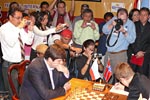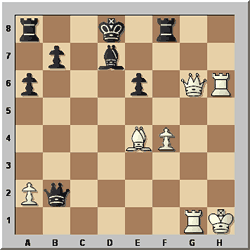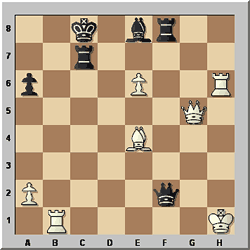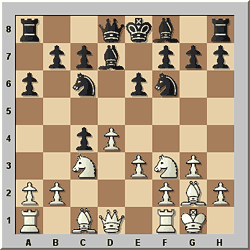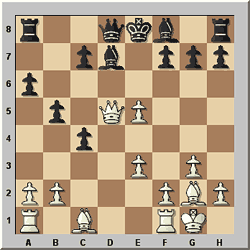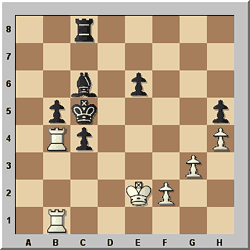
Round seven
Round 7: Sunday, February 25th |
| Peter Leko |
0-1 |
Vishy Anand |
Vassily Ivanchuk |
1-0 |
Levon Aronian |
Veselin Topalov |
1-0 |
Alex. Morozevich |
Peter Svidler |
½-½ |
Magnus Carlsen |
|
Standings after seven rounds
After this round the tournemant continues in Linares, Spain, starting on March
2nd.and ending on March 10. Tomorrow, Monday February 26 is transfer day. All
players, their seconds, wives, companions, distant acquaintances, the Spanish
staff, the journalists, everyone vaguely connected with the tournament, have
been instructed to be outside the Los Juaninos Hotel, where most of the players
are staying, at 9:30 sharp, to board a bus which will take us to Mexico City
airport. There, after waiting for about five hours, we will, all of us, board
a Aero Mexico flight at 18:35h to arrive in Madrid: the next day at noon (local
time). From there most of the players will proceed to Linares and sleep for
26 hours. By March 2nd they will hopefully have reset their internal clocks
and be ready to play again.
We of the ChessBase team will also be out of commission for the same period
of time – until Tuesday evening European Time. That is when we will resume
our reporting. We hope our readers will bear with us and not suffer too harshly
from this 28-hour news blackout. How about a nice book, or a picnic with the
family, to bridge the time. We will return to reporting on the Morelia-Linares
event, with a number of still-to-be-told excursion stories, as soon as possible.
Commentary by GM Mihail Marin
The following express commentary was provided by Romanian GM Mihail Marin,
who is the author of a number of very popular ChessBase training CDs and articles
for ChessBase Magazine. GM Marin will study the games of the Morelia/Linares
tournament in greater detail and provide the full results of his analysis in
the next issue of ChessBase
Magazine.
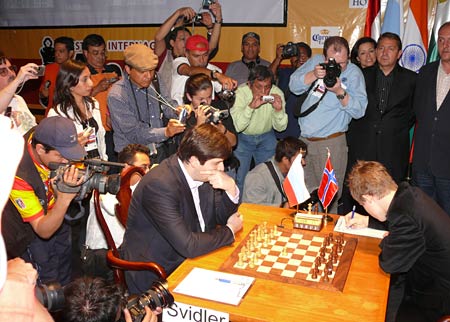
Photographes going nuts over Svidler vs Carlsen
Svidler,P (2728) - Carlsen,M (2690) [B35]
XXIV SuperGM Morelia/Linares MEX/ESP (7), 25.02.2007 [Mihail Marin]
1.e4 c5 2.Nf3 Nc6 3.Nc3 g6 4.d4 cxd4 5.Nxd4 Bg7 6.Be3 Nf6 7.Bc4 0-0 8.Bb3
8...e6!? An interesting atempt to take advantage of the presence of the
d-pawn on its initial square. 8...d6 would have transposed to a genuine Dragon.
9.0-0 d5 10.exd5 Nxd5 11.Nxd5 exd5 12.c3 Na5 new 13.Qd3 Nxb3 14.axb3
a6 15.Qd2 Re8 16.Rfe1 Bd7 17.Nc2 Bc6 18.Bd4
18...f6! Optically speaking, an "ugly" move, creating a weakness
and restricting the own bishop. However, this is the lesser evil in this position.
Allowing the exchange of the dark-squared bishops would have left Black's position
in ruins. 19.Rxe8+ Qxe8 20.h3 Qf7 21.Nb4 Bf8 22.Nxc6 bxc6 23.b4 Bd6 24.b5
cxb5 25.Bxf6 a5 26.Bd4 Qf4 27.Qxf4 1/2-1/2. [Click
to replay]
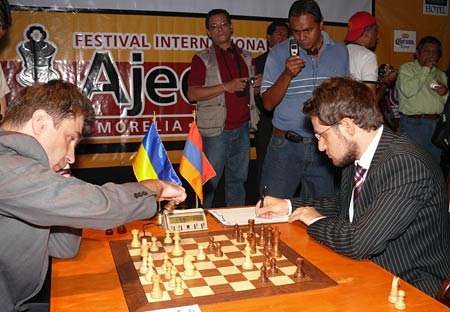
Somewhat less attention given to Ivanchuk vs Aronian
Ivanchuk,V (2750) - Aronian,L (2744) [D38]
XXIV SuperGM Morelia/Linares MEX/ESP (7), 25.02.2007 [Mihail Marin]
1.d4 Nf6 2.c4 e6 3.Nf3 d5 4.Nc3 Bb4 5.Bg5 Nbd7. In spite of the dangers
he had passed through in his earlier game against Morozevich, Aronian did not
lose faith in this variation. 6.cxd5 exd5 7.Qc2 Ivanchuk chooses a quiet
system of development, which is not without poison as we shall see. 7...c5
8.a3 Bxc3+ 9.Qxc3 h6 10.Bxf6. Consequent to his linear strategy. 10.Qe3+
was played in Van Wely-Sargissian, Bundesliga 2006 and Van Wely-Aronian, Wijk
aan Zee 2007, which might be a hint that this line is an Armenian specialty.
10...Qxf6 11.e3 0-0 12.Be2 b6 13.0-0 Bb7.
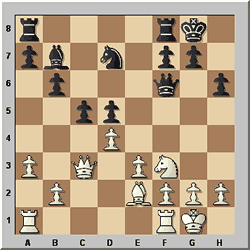
The position is characteristic for the Tartakower-Makagonov-Bondarevsky variation
of the Queen's Gambit declined. The main differences are that in the QGD the
queens find themselves in opposition on the a3-e7 diagonal and that the black
bishop is developed slightly more actively on e6. 14.Rfc1. A novelty.
White usually developes the other rook on c1. 14...Rac8 15.dxc5 Qxc3 16.Rxc3
Rxc5. Black cannot maintain the compactness of his structure with 16...bxc5
because of 17.b4 , ensuring White the control of the d4-square. The point behind
Ivanchuk's novelty is revealed after 17...cxb4 18.Rxc8 Rxc8 19.axb4 when the
queen's rook is optimally placed on its initial square. 17.Rcc1!? A
paradoxical move. White is not sufficiently well prepared to fight for the control
of the c-file with 17.Rac1 because of 17...Rfc8 when 18.Rxc5 bxc5 19.b4 cxb4
leads to simplification and a probable draw, in spite of Black's isolated pawn.
One general rule states that the side playing against the isolani should keep
as many major pieces on board and try to provoke the exchange of minor pieces,
in order to successfully attack the relative weakness of the central pawn. From
this perspective, Ivanchuk's willing retreat is easy to understand. 17...Rfc8?!
Obviously missing White's idea. Safer would have been 17...Rxc1+ 18.Rxc1
Rc8. 18.Rd1! Of course. Black's activity along the c-file will have a
temporary character, while the pressure against the d5-pawn will be permanent.
18...Rc2 19.Bb5 Nf8 20.Rab1 R2c7 21.Ba4 Ne6 22.Bb3 Kf8 23.h3 Rc5 24.Kh2 Ke7
25.Rd2 Rb5 26.Ba2 Rbc5 27.Ne1 a5 28.Rbd1 Rd8 29.Kg3 Rb5 30.f3.

White has a pleasant position, but there is a long way till achieving something
more concrete still. 30...Rc8? Rather careless. Black should have brought
the other rook into safety with 30...Rc5. 31.Nd3! Suddenly, the rook
is trapped. The threat a4 is hard to prevent in adequate way. 31...d4.
Other moves also lose this pawn, for instance 31...a4 32.Nb4 Nc7 33.e4 when
33...dxe4 34.Rd7+ leads to a devastating attack; or 31...Nc5 32.Nf4 Na4 33.Bxd5
Bxd5 34.Nxd5+ when the central knight compensates for the presure against the
b2-pawn. 32.Bxe6 Kxe6 33.Nf4+ Ke7 34.Rxd4 Rc7 35.R1d2.
White is basically winning now, but Aronian went down rather quickly, possibly
demoralized by the unexpected course of events. 35...Rbc5 36.e4 Rc4 37.Rd6
R4c6 38.e5 Rc2 39.Rxc2 Rxc2 40.Rxb6 Bc6 41.b4 g5 42.Nh5 axb4 43.axb4 Bd5 44.Ng7
Re2 45.Nf5+ Ke8 46.Nxh6 Be6 47.Rb5 Rb2 48.Rb8+ Kd7 49.Rg8 1-0. [Click
to replay]

No handshake or eye contact accorded to Topalov (seft) by Morozevich
Topalov,V (2783) - Morozevich,A (2741) [C11]
XXIV SuperGM Morelia/Linares MEX/ESP (7), 25.02.2007 [Mihail Marin]
1.e4 e6 2.d4 d5 3.Nc3 Nf6 4.e5 Nfd7 5.f4 c5 6.Nf3 Nc6 7.Be3 a6 8.Ne2.
A rare move, aimed to consolidate the d4-square at the cost of delaying the
development of the queenside The normal continuation is. 8.Qd2 . I would quote
here a recent example form the practice of another great French expert, which
bears some similarity with our main game: 8...b5 9.a3 g5!? and Black managed
to undermine White's centre, although the position remained complicated, Jakovenko-Bareev,
Sochi 2006. 8...Qb6 9.Qc1.
9...g5!? Not only typical for the French opening, but also for Morozevich'
enterprising and original style of play. However, the tension created by this
move has a double edged character. Black is not allowed to slow down his initiative,
because otherwise several of his minor pieces (the d7-knight, the c8-bishop) would
remain passive. 10.c3 cxd4 11.cxd4 Bb4+ 12.Kf2 f6 13.g3 Rf8 14.Kg2 g4 15.Nh4
Rg8. Optically speaking, 15...f5 looks safer, but in this case Black would
have needed several tempi to complete his development. White could use this time
to "organize" some piece sacrifice for two pawns in order to get a threatening
central avalanche. 16.h3 h5 17.hxg4 hxg4 18.Nc3 fxe5 19.fxe5.
19...Ncxe5!? Another typical sacrifice. Black solves the problems of development
in radical way, putting the enemy king in danger at the same time. Apparently,
Morozevich is delighted with having such positions with either colour. During
the World Championship held in Moscow he managed to repel Gurevich' attack and
convert his extra-piece into a win, which proved decisive for the final result
of their mini-match. In our concrete case, the sacrifice might not be entirely
sound, but is hard to meet over the board. Besides, in case of a neutral developing
move such as 19...Nf8 (preparing ...Bd7 and ...0-0-0), White could consider sacrificing
himself with 20.Nf5!? 20.dxe5 d4 21.Na4 Qa5 22.Qc4 Nxe5 23.Qxd4. Black
has only a pawn for his piece, but the position is completely chaotic. The following
phase of the game is hard to comment without a deeper analysis. I would say only
that up to a certain point Morozevich managed to outplay his mighty opponent.
23...Nf3 24.Nxf3 gxf3+ 25.Kf2 Qxa4 26.Bd3. Black has returned his material
advantage for the sake of rapid development. However, the position of his king
remains relatively exposed. 26...Qd7 27.Qe4 Bd6 28.Rag1 Qg7 29.Rh6 Qxb2+ 30.Kxf3
Rf8+ 31.Bf4 Qe5 32.Qg6+ Kd8 33.Kg2 Qb2+ 34.Kh1 Bxf4 35.gxf4 Bd7 36.Be4.
36...Kc7? Rather careless. 36...Qd4 , centralising the queen or; 36...Rh8
, aiming for simplifications, were entirely viable. 37.Rb1 Qf2 38.Rxb7+?
This premature check leaves the win slip away (true, only temporarily). It would
have been better to keep the threat of capturing on b7 in reserve with 38.Qg7
, adding a new one: Rh7. Black would have been without defence. 38...Kc8 39.Rb1
Ra7 40.f5 Rc7? A fatal mistake, just before the time control. It is not easy
to foresee why this move is losing, but on general ground, centralising the queen
with tempo would have been a wise idea. For instance 40...Qf4 and only after 41.Re1
the rook could come into play with 41...Rc7 . The main difference is that after
42.fxe6? Be8 the h6-rook is hanging. 41.fxe6 Be8 42.Qg5.
White is a pawn up and his king is in absolute safety. The long diagonal, the
h-file and the back rank are well defended. The black king is under no immediate
threat, but one can smell the danger approcahing. 42...Qd4. It is too
late now for 42...Qf4 because of 43.Qxf4 Rxf4 44.Rh8 Re7 45.Bg6 , winning the
bishop. 43.Bg2 Rf4 44.e7 Rc5 45.Qg3 Rc3 46.Qe1 Re3 47.Qa5 Bb5 48.Rc1+ 1-0.
[Click to replay]

Peter Leko vs Vishy Anand – the two are friends and have
worked together
Leko,P (2749) - Anand,V (2779) [E04]
XXIV SuperGM Morelia/Linares MEX/ESP (7), 25.02.2007 [Mihail Marin]
1.d4 Nf6 2.c4 e6 3.g3 d5 4.Nf3 dxc4 5.Bg2 a6 6.0-0 Nc6 7.e3 Bd7 8.Nc3.
8...b5. This rare move is generally underestimated by theory. 8...Rb8
is supposed to be the main line when only after 9.Qe2 Black defends the pawn with
9...b5. I had a pleasant experience against the over-ambitious 8...Bb4 9.Qe2 b5
10.Ne5 Nxe5 11.dxe5 Bxc3 12.bxc3 Nd5 13.Ba3 Nxc3 14.Qg4 g6 15.Rac1 h5 16.Qf3 Nd5
17.Rfd1 a5 18.Bc5 Ra6 19.a4 b4 20.Bf1 Rc6 21.Rxc4 and Black soon collapsed under
the pressure in Marin-Graf, Sanxenxo 2004.; 8...Nd5 is another sideline, possibly
unjustly doomed by older theory. In a recent game Black managed to hold his own:
9.Nd2 Nb6 10.Qe2 Na5 11.Nde4 Be7 12.Nc5 Bc6 13.Bxc6+ Nxc6 14.Nxb7 Qc8 15.Nc5 0-0
. Black's better development compensates for his structural deffects, Kramnik-Carlsen,
Wijk aan Zee 2007. 9.Ne5 Nxe5 10.dxe5 Nd5 11.Nxd5 exd5 12.Qxd5.
The position is highly assymetrical. In the long run, Black's queenside pawns
could become dangerous, but for the moment he has to solve the concrete problem
of completing his development. 12...Rb8. A new move. 12...c6 was played
in Khalifman-Shulman, Khanty Mansiysk 2005. Black managed to survive the opening
and obtained a better rook ending with a queenside majority. 13.a4. Aiming
to activate the queen's rook, but weakening the b4-square. The main alternative
was 13.Rd1 , developing the other rook and maintaining a4 in reserve. 13...Bb4
14.Rd1 Qe7 15.Bd2 Bc5. Black has managed to obtain some stability now, but
his problems are far from being over. 16.axb5 axb5 17.Ba5. This way of
developing the bishop is characteristic for the main lines where Black captures
on c4 after castling. 17...c6 18.Qd2. Black cannot castle because the d7-bishop
is hanging. He cannot play ...Be6 because of the hanging c6-pawn. This means that
he is far behind in development still. 18...Rc8 19.Rac1 h5. 19...Be6 is
still impossible because of 20.Bxc6+! Rxc6 21.Qd8+ , winning the h8-rook. 20.b4
Ba7 21.Ra1 Rh6 22.Qc3 Bf5 23.e6 Rxe6 24.Qxg7.
24...Bg4 25.Rd2?! White misses an elegant combination: 25.Bxc6+! Rexc6
and now, after the unexpected 26.Bd8! most of Black's pieces are hanging. 25...Bb8
26.h3 Be5 27.Qg8+ Qf8 28.Qxf8+ Kxf8 29.Rc1 Bf5. Black has repelled the attack
and can look into the near future with optimism. His queenside pawns will become
threatening soon. 30.e4 Bh7 31.Bb6 Bf6 32.h4 Bxe4 33.Bh3 Bd5 34.Bxe6 fxe6.
"Winning" the exchange does not absolve White from problems. 35.Bc5+
Be7. Unblocking the pawns. 36.Bxe7+ Kxe7 37.Rb2 Kd6 38.Kf1 c5 39.Ke2 cxb4
40.Rxb4 Kc5 41.Rcb1 Bc6.
White's resignationmight look a bit premature, but in fact there is nothing
he can do against the enemy pawns supported by all Black's pieces. 0-1.
[Click to replay]

A view from the top: the Theatre in Morelia with the games in progress
Schedule and results
Round 1: Saturday, February 17th |
| Vassily Ivanchuk |
½-½ |
Peter Leko |
Veselin Topalov |
½-½ |
Vishy Anand |
Peter Svidler |
½-½ |
Levon Aronian |
Magnus Carlsen |
1-0 |
Alex. Morozevich |
|
|
Round 2: Sunday, February 18th |
Peter Leko |
½-½ |
Alex. Morozevich |
Levon Aronian |
½-½ |
Magnus Carlsen |
Vishy Anand |
½-½ |
Peter Svidler |
Vassily Ivanchuk |
1-0 |
Veselin Topalov |
|
|
Round 3: Monday, February 19th |
Veselin Topalov |
½-½ |
Peter Leko |
Peter Svidler |
½-½ |
Vassily Ivanchuk |
Magnus Carlsen |
0-1 |
Vishy Anand |
Alex. Morozevich |
½-½ |
Levon Aronian |
|
|
|
Free day: Tuesday, February 20th |
|
Round 4: Wednesday, February 21st |
Peter Leko |
½-½ |
Levon Aronian |
Vishy Anand |
1-0 |
Alex. Morozevich |
Vassily Ivanchuk |
0-1 |
Magnus Carlsen |
Veselin Topalov |
½-½ |
Peter Svidler |
|
|
Round 5: Thursday, February 22nd |
Peter Svidler |
½-½ |
Peter Leko |
Magnus Carlsen |
1-0 |
Veselin Topalov |
Alex. Morozevich |
½-½ |
Vassily Ivanchuk |
Levon Aronian |
1-0 |
Vishy Anand |
|
|
|
Free day: Friday, February 23rd |
|
Round 6: Saturday, February 24th |
Magnus Carlsen |
½-½ |
Peter Leko |
Alex. Morozevich |
½-½ |
Peter Svidler |
Levon Aronian |
½-½ |
Veselin Topalov |
Vishy Anand |
½-½ |
Vassily Ivanchuk |
|
|
Round 7: Sunday, February 25th |
| Peter Leko |
0-1 |
Vishy Anand |
Vassily Ivanchuk |
1-0 |
Levon Aronian |
Veselin Topalov |
1-0 |
Alex. Morozevich |
Peter Svidler |
½-½ |
Magnus Carlsen |
|
|
|
Transfer to Linares, Spain |
|
Links
